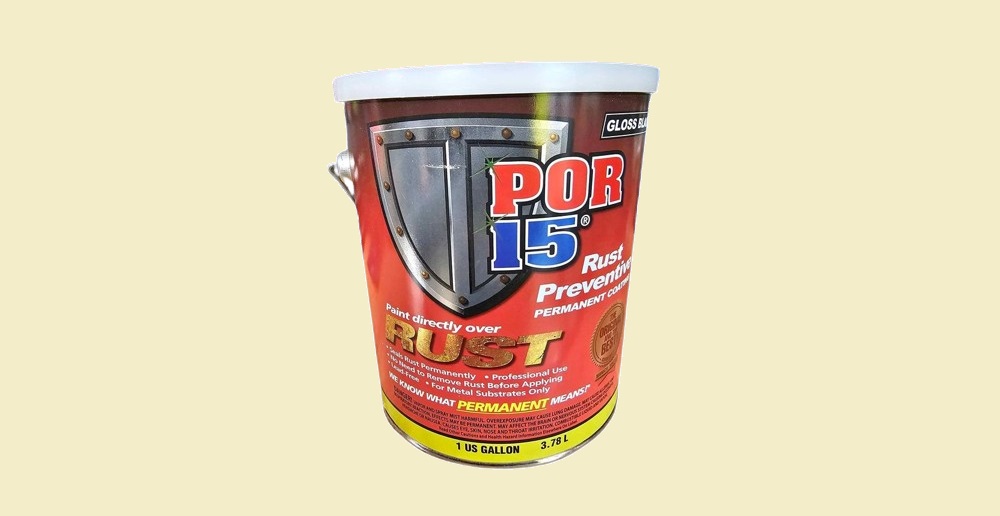When protecting metal surfaces from corrosion, POR-15 is a go-to choice for many. Traditionally celebrated for its rust-preventive properties on ferrous metals like steel and iron, POR-15 can also be highly effective for non-ferrous metals like aluminum.
Although aluminum doesn’t rust in the traditional iron-oxide sense, it’s not immune to corrosion. Oxidation can tarnish its appearance and integrity, leading to a phenomenon known as aluminum corrosion, which is where POR-15 steps in.
Understanding how to tailor the application process for aluminum is essential because of its unique properties.
By adapting your approach, you can ensure that POR-15 adheres properly, providing durable, long-lasting protection against the elements. Below, we will discuss the preparatory steps necessary for a successful application.

Table of Contents
Surface Preparation
Cleaning the Aluminum Surface
Removing Contaminants:
The first step is to ensure that the aluminum surface is immaculately clean. Oils, grease, or other contaminants can hinder the adhesion of POR-15.
Use a degreaser or a solvent like acetone to remove these impurities effectively. This ensures that the surface is perfectly prepped for further treatment.
Final Washing:
After degreasing, wash the surface with soapy water to remove residual solvent and debris. Rinse it thoroughly to ensure no soap remains, then allow the aluminum to dry completely.
This step is crucial as any moisture remaining on the surface can affect the performance of the subsequent layers.
Removing Oxidation
Abrasive Techniques:
Removing this layer is essential to ensure the POR-15 can bond effectively if the aluminum shows signs of oxidation.
Use a wire brush, sandpaper, or a chemical etcher designed explicitly for aluminum. This clears the oxidation and roughens the surface slightly, which is beneficial for the next step.
Enhancing Surface Texture:
Sanding the aluminum after cleaning creates a slightly rough texture, which is ideal for the paint to latch onto. This micro-abrasion is critical to promote good adhesion of the POR-15, setting the stage for a lasting protective coating.
2. Etching the Aluminum
Applying an Etching Primer
Choosing the Right Primer:
Before applying POR-15, it’s crucial to use a self-etching primer formulated for aluminum. This type of primer contains acids that etch the metal surface, creating an ideal substrate for the paint.
The etching process ensures the paint adheres more securely, preventing peeling and flaking over time.
Application Techniques:
Apply the etching primer using a spray can or brush, depending on the surface’s size and complexity.
Before application, ensure the aluminum is completely dry and dust-free. Spray or brush the primer evenly, covering all areas thoroughly but without over-application, which can lead to runs and sags.
Letting It Cure:
After application, it’s essential to allow the primer to cure fully according to the manufacturer’s instructions. Cure times can vary but typically range from 30 minutes to 1 hour.
Proper curing is essential for the primer to function effectively and provide a strong foundation for the POR-15.
3. Applying POR-15
Mixing POR-15
Preparation of the Paint:
It would be best if you prepared POR-15 correctly before applying it. Stir the paint thoroughly to ensure that all components are evenly mixed.
Avoid shaking the can, as this can introduce air bubbles into the paint, which might affect the finish and durability of the coating.
Applying POR-15
Application Environment:
Ensure that the environment is clean and free from dust and moisture. Any particles in the air can stick to the wet surface and become embedded in the finish.
First Coat Application:
Apply POR-15 in thin, even coats using a brush or a sprayer. The first coat should be thin, allowing it to penetrate the primer and create a strong bond.
Allow this coat to become tacky to the touch; depending on the ambient temperature and humidity, this may take a few hours.
Second Coat:
If necessary, apply a second coat to ensure complete coverage and optimal thickness for protection. The second coat should be applied while the first is still slightly tacky but firm enough to support another layer. This ensures the best mechanical bond between layers.
Curing
Drying Time:
Allow POR-15 to cure for 24-48 hours before exposing the aluminum to heavy use. The full cure, where POR-15 reaches its maximum hardness and protective properties, develops over several days, depending on temperature and humidity.
4. Post-Application
Inspecting and Touch-Ups
Inspection for Flaws:
After the curing period, inspecting the coated surface carefully is essential. Look for missed spots, bubbles, or inconsistencies in the finish. Proper inspection ensures that the entire surface is uniformly protected, which is necessary for long-term durability.
Applying Additional Coats:
If you find areas that need more coverage or if there are minor imperfections, additional POR-15 can be applied.
Ensure these touch-ups are done carefully to blend seamlessly with the cured surface. This step is crucial for maintaining the integrity and aesthetics of the protective coating.
Conclusion
Following these steps ensures your aluminum surfaces are well-protected against corrosion and maintain a professional, high-quality finish.
With each phase thoroughly executed, the aluminum is now safeguarded with a durable, resilient coating that will extend its lifespan significantly.
